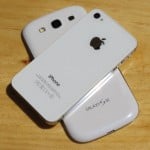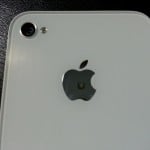The Samsung Galaxy S III is starting to roll out in the US, and unlike most Android handsets that ship with a mediocre camera, the Galaxy S III has an 8-megapixel shooter that makes the handset one of the best Android camera phones on the market. To see how the S III compares to the iPhone 4S, we spent some time with both camera phones, shooting pictures and video under a variety of conditions.
Camera Hardware
 Underneath the hood, there’s not a huge difference between the iPhone 4S sensor and the one in the Galaxy S III. Tear down analysis from Chipworks and iFixit reveal that the two handsets both use a Sony back-illuminated sensor. The sensors are similar, but not identical. In its teardown, Chipworks writes this about the sensor in the Galaxy S III,
Underneath the hood, there’s not a huge difference between the iPhone 4S sensor and the one in the Galaxy S III. Tear down analysis from Chipworks and iFixit reveal that the two handsets both use a Sony back-illuminated sensor. The sensors are similar, but not identical. In its teardown, Chipworks writes this about the sensor in the Galaxy S III,
The bond pad arrangement is not the same as the IMX145 found in the iPhone 4S nor is it the same as the IMX105 found in previous Samsung phones. The initial opinion (subject to more analysis) is that the sensor is new.
Based on manufacturer specs and exif data, the iPhone 4S has an 8-megapixel sensor with a 4.28mm focal length and f/2.4 maximum aperture. The Galaxy S III, however, has a 3.7mm focal length and f/2.6 maximum aperture. The aperture differences are minor, but the slight variation in focal length had an effect on the resulting image. I noticed the effect of the focal length when taking portraits or other photos that centered on a subject. The Galaxy S III shots had a wider field of view and grabbed more of the surroundings, while the iPhone 4S centered more on the subject.
The other big difference between the two handsets is the size of the screen. Needless to say, photo taking was a pleasure on the Galaxy S III because of the big screen. Reviewing photos and videos saved in the gallery was also stunning on the Galaxy S III. The iPhone 4S has a gorgeous retina display, too, but its smaller size lacks the “wow” factor you have in the Galaxy S III.
Camera Design
 Neither the iPhone 4S nor the Galaxy S III has a dedicated hardware button to launch the camera. Both use on-screen buttons and both can launch the camera app from the lock screen. The iPhone 4S is a bit easier to launch from the lock screen as all you have to do is drag up the camera icon to reveal the camera app. The Galaxy S III lets you swipe on the camera icon to launch the camera, but there was a slight lag as the OS switched to the camera app. I did notice that the camera launched much faster when the camera was the last app you used before locking your phone.
Neither the iPhone 4S nor the Galaxy S III has a dedicated hardware button to launch the camera. Both use on-screen buttons and both can launch the camera app from the lock screen. The iPhone 4S is a bit easier to launch from the lock screen as all you have to do is drag up the camera icon to reveal the camera app. The Galaxy S III lets you swipe on the camera icon to launch the camera, but there was a slight lag as the OS switched to the camera app. I did notice that the camera launched much faster when the camera was the last app you used before locking your phone.
The camera for the Galaxy S III is located top middle part of the back side of the phone. On one side of the camera is the flash and the other is a speaker. There’s microphone at the top which does a surprisingly good job capturing audio. As long as you hold the phone on the outside nd curl your fingers only slightly over the edges, your digits will stay safely out of the way of the lens. The phone itself is very thin and slippery which makes it hard to hold for action scenes. I would recommend a case if you wanted to do some active shooting. The iPhone 4S, however, has its lens and flash near the edge of the handset. If you are not careful, you can inadvertently dangle your fingers in front of the lens or flash and mess up a perfectly good photo opportunity. Handling-wise, the iPhone is thicker than the Galaxy S III, which makes it easier to use without a case.
My biggest complaint about the Galaxy S III was the touch-sensitive panel on the front of the phone. Many times I accidentally hit the back button while trying to adjust the camera and quit myself out of the camera app. It was extremely frustrating, especially when you are trying to take a quick shot. I tried to hold the phone differently, but I still couldn’t avoid the casual touch that would back me out of the camera app. The iPhone does not suffer from this problem as the only button to exit you out of the camera app is the home button, which takes more than a casual glance to activate.
Camera Software
 The software on the Galaxy S III is significantly different from the iPhone 4S, with the S III offering a bevy of options for the camera phone photographer. Anyone who has used an iPhone knows that iOS has a basic user interface for the camera. You can toggle between the camera and video camera, toggle the flash, and switch between the front-facing and rear-facing camera. You can also set a few options which include turning on/off the on-screen grid and HDR. In the iOS video camera, you can only turn on/off the flash and switch between the two cameras. It’s a pretty bare bones experience. Fortunately, the iOS App Store has a lot of replacement camera apps and photo/video editors that make up for the default iOS camera.
The software on the Galaxy S III is significantly different from the iPhone 4S, with the S III offering a bevy of options for the camera phone photographer. Anyone who has used an iPhone knows that iOS has a basic user interface for the camera. You can toggle between the camera and video camera, toggle the flash, and switch between the front-facing and rear-facing camera. You can also set a few options which include turning on/off the on-screen grid and HDR. In the iOS video camera, you can only turn on/off the flash and switch between the two cameras. It’s a pretty bare bones experience. Fortunately, the iOS App Store has a lot of replacement camera apps and photo/video editors that make up for the default iOS camera.
 The Galaxy S III is the antithesis to the iOS camera. It is filled with shooting options including panorama, smile shot, cartoon and more. There’s also a burst mode that’ll shoot eight photos in a row and let you select the best ones to save. There are several scene modes that automatically customize the camera’s settings for shooting a portrait, landscape, night, indoors, sports, dawn, fall color, text, fireworks and more. And if that wasnt enough you can even set the white balance, change the exposure, use an anti-shake feature, and add a GPS tag. Many of these options carry over to video mode, so you can tweak your videos as well.
The Galaxy S III is the antithesis to the iOS camera. It is filled with shooting options including panorama, smile shot, cartoon and more. There’s also a burst mode that’ll shoot eight photos in a row and let you select the best ones to save. There are several scene modes that automatically customize the camera’s settings for shooting a portrait, landscape, night, indoors, sports, dawn, fall color, text, fireworks and more. And if that wasnt enough you can even set the white balance, change the exposure, use an anti-shake feature, and add a GPS tag. Many of these options carry over to video mode, so you can tweak your videos as well.
Beyond the options, both cameras let you tap on the screen to focus and use a gesture to zoom. The zoom controls are easy to use on both handsets, though they are a little different. The iPhone uses a pinch-to-zoom gesture and has a nice slider that let’s you fine tune the zoom. The S III also uses a pinch-to-zoom, but it displays a box with the zoom magnification. Both phones had about the same zoom capability and both showed degradation of the images when zoomed into a subject in the distance. When you used zoom for a macro shot, both cameras took superb images.
Once you take a photo with the iPhone 4S, a preview appears in the bottom right corner. Clicking on the preview launches the Photos app where you can share and edit the photo. There’s also a camera icon so you can jump right back into shooting. Just like the iPhone, the Galaxy S III includes a preview of your previous photo in the bottom right corner. Clicking on the preview launches the Gallery app where you can share and edit the photo. There is no camera icon, but you can hit the back button and hop back into the camera.
When it comes to editing your photos, the iPhone 4S and Galaxy S III are on par. Both phones have basic built-in editors that let you crop and edit your photo. The editing on the Samsung phone is handled by Samsung’s CameraLab app which is available for free from Samsung’s app store. The app lets you tweak the colors of the photo, add borders and frames and drop decorations onto your photo. Once CameraLab is installed, you can launch the app when you are viewing a photo in the photo gallery. On the iPhone 4S, editing is handled by the default Gallery app. When you are viewing a photo, you can crop, rotate, remove red eye and use an auto-enhance feature that’ll improve the color quality of the photo.
When you’re done editing, both phones let you share your photos with others or upload them to a hosting service. The iPhone 4S lets you share a photo using MMS, Twitter and email. You can you assign a photo to a contact, print a photo or use it as a wallpaper. iOS also has Air Display which will let you view your photos and videos on your HDTV via an Apple TV. The Galaxy S III has an impressive array of built-in third-party services such as Flipboard, Google +, ChatOn and Groupcast. You can also upload your photos to Picasa and Dropbox. Traditional sharing options include email and messaging. And for those who prefer to use their photos privately, you can send a photo to Samsung’s S-Memo memo application or transfer photos to another device using Bluetooth or WiFi Direct.
Image Quality and Camera Performance
 Besides the hardware and software differences mentioned above, I noticed two main differences in image quality between the Galaxy S III and the iPhone 4S. First, the Galaxy S III did a better job with the flash when shooting indoors. I took a lot of pictures of my kids playing inside and the S III did a decent job capturing the skin tone and shadows on their faces. The iPhone 4S, however, tended to overexpose the picture and made their skin appear bleached out. You can’t turn down the exposure on the iPhone 4S with the default camera app so you have to adjust your camera technique by backing away from your subject before taking a flash photo.
Besides the hardware and software differences mentioned above, I noticed two main differences in image quality between the Galaxy S III and the iPhone 4S. First, the Galaxy S III did a better job with the flash when shooting indoors. I took a lot of pictures of my kids playing inside and the S III did a decent job capturing the skin tone and shadows on their faces. The iPhone 4S, however, tended to overexpose the picture and made their skin appear bleached out. You can’t turn down the exposure on the iPhone 4S with the default camera app so you have to adjust your camera technique by backing away from your subject before taking a flash photo.
The second difference I noticed was outdoors. Especially with outdoors photography, the iPhone did a slightly better job than the S III at capturing the colors of the environment. In my landscape photo above, the iPhone 4S captured the sky with the correct shade of blue and a nice contrast with the clouds. The green on the trees was also spot on with the iPhone 4S. The S III tended to brighten things up a tad too much in bright sun, making the clouds too white and both the sky and the trees a bit washed out. It wasn’t horrible and it could be fixed easily in post-processing, but that is an extra step for those who take a lot of their photos outdoors. It’s worth mentioning that you could also fix this overexposure by adjusting the exposure in the camera settings before taking a picture. This ability to tweak settings on the fly is missing in the default camera on the iPhone and one of its biggest detractors in my opinion.
Perfromance wise, The S III was slightly slower at focusing and firing up the flash, but it was worth it to get a better quality, close up photo indoors. Without the flash, the two cameras focused and fired off shots at a similar pace. Movement, especially indoors, was a challenge for both cameras. Many times, I had a cute shot of my child smiling and he or she would move their head slightly and the image was blurred. This is a limitation I’ve seen on all camera phones that I have used. Outdoor action shots were a bit less blurry, but you’re not going to get DSLR or even high-end point and shoot quality with a camera phone.
Sample Photos
All photos were taken at the same time, under the same conditions. The cameras were set to their default settings including autofocus and autoflash. Any deviations, like adjusting the zoom, were noted in the image captions. Images were not cropped or enhanced. They were only resized using Photoshop’s bulk resize tool.
- Galaxy S III – Outdoor landscape
- iPhone 4S – Outdoor Landscape
- Galaxy S III – Zoom
- iPhone 4S – Zoom
- Galaxy S III – Text
- iPhone 4S – Text
- Galaxy S III – Text Color
- iPhone 4S – Text Color
- Galaxy S III – Portrait
- iPhone 4S – Portrait
- Galaxy S III – Indoor, Low Light with No Flash
- iPhone 4S – Indoor, Low Light with No Flash
- Galaxy S III – Indoor, Low Light with Flash
- iPhone 4S – Indoor, Low Light with Flash
- Galaxy S III – Indoor with Flash
- iPhone 4S – Indoor with Flash
- Galaxy S III – Indoor, Bright Light, No Flash
- iPhone 4S – Indoor, Bright Light, Not Flash
- Galaxy S III – Outdoor, Sunlight, Color
- iPhone 4S – Outdoor, Sunlight, Color
- Galaxy S III – Outdoor, Sunlight
- iPhone 4S – Outdoor Sunlight
- Galaxy S III – Macro
- iPhone 4S – Macro
- Galaxy S III – Outdoor, Sunlight
- iPhone 4S – Outdoor Sunlight
- Galaxy S III – Outdoor, Sunlight, Group
- iPhone 4S – Outdoor Sunlight Group
- Galaxy S III – 3 Photo Panorama
- Galaxy S III – 5 Photo Panorama
- Landscape side-by-side
- Galaxy S III and iPhone 4S camera
- Galaxy S III camera
- iPhone 4S camera
- Galaxy S III Camera options
- iPhone 4S camera options
Sample Videos
Both videos were taken at the same time, under the same conditions. The cameras were set to their default settings including autofocus and autoflash. Videos were not cropped or enhanced. They were only uploaded to YouTube.
The Final Take
Overall, it’s a toss up between the iPhone 4S and the Galaxy S III as both camera phones take excellent photos. The iPhone 4S camera may not have all the shooting options as the S III, but it has a robust App Store with apps that’ll let you manipulate your photos in a myriad of ways. If you don’t mind paying some extra for apps like Camera Awesome or iMovie for iOS, then the iPhone is an excellent choice. It’s also a nice pocketable size which makes it easy to grab and go.
The larger screen of the Galaxy S III was awesome for previewing your scene, even if the bigger size made the S III sometimes awkward to hold. It’s a trade-off, though, as the S III has a lot of built-in shooting options that’ll appeal to casual shutter bugs who want to tweak settings before taking a shot. Purists who prefer post-processing to clean up photos may prefer the no-frills experience of the iPhone 4S.
For the casual photographer like me, the differences between the two are minor. It really comes to down to personal preference about the phone and the OS. Do you like iOS or Android? Do you like a larger phone or a smaller phone? In the end, you can’t go wrong with the camera on either phone.




































